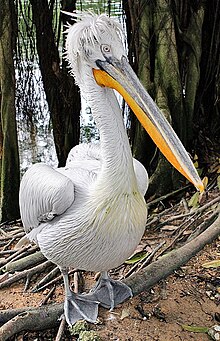Dalmatian pelican: Difference between revisions
m robot Adding: pnb:ڈالمیٹین پیلیکان |
No edit summary |
||
| Line 33: | Line 33: | ||
==External links== |
==External links== |
||
*[http://www.acopiancenter.am/boa.asp?id=26 A Field Guide to Birds of Armenia: Dalmation Pelican] |
|||
*[http://www.birdlife.org/datazone/species/index.html?action=SpcHTMDetails.asp&sid=3811&m=0 BirdLife Species Factsheet.] |
*[http://www.birdlife.org/datazone/species/index.html?action=SpcHTMDetails.asp&sid=3811&m=0 BirdLife Species Factsheet.] |
||
*[http://ec.europa.eu/environment/nature/directive/birdactionplan/pelecanuscrispus.htm European Commission for Environment: Action plan for the Dalmatian Pelican] |
*[http://ec.europa.eu/environment/nature/directive/birdactionplan/pelecanuscrispus.htm European Commission for Environment: Action plan for the Dalmatian Pelican] |
||
Revision as of 15:15, 25 November 2010
| Dalmatian Pelican | |
|---|---|

| |
| Scientific classification | |
| Kingdom: | |
| Phylum: | |
| Class: | |
| Order: | |
| Family: | |
| Genus: | |
| Species: | P. crispus
|
| Binomial name | |
| Pelecanus crispus Bruch, 1832
| |
The Dalmatian Pelican (Pelecanus crispus) is a member of the pelican family. It breeds from southeastern Europe to India and China in swamps and shallow lakes. The nest is a crude heap of vegetation.

This is the largest of the pelicans, averaging 170–190 cm (67-75 inches) in length, 11–15 kg (24-33 lbs) in weight and just over 3 m (10 ft) in wingspan. On average, it is the world's heaviest flying species, although large male bustards and swans can exceed the pelican in maximum weight. It differs from the White Pelican in that it has curly nape feathers, grey legs and greyish-white (rather than pure white) plumage. It has a red lower mandible in the breeding season. Immatures are grey and lack the pink facial patch of immature White Pelicans. The latter also has darker flight feathers.
This pelican migrates short distances. In flight, it is an elegant soaring bird, with the flock moving in synchrony. The neck is then held back like a heron's.
As is well known, pelicans catch fish and small birds in their huge bill pouches.

Like the White Pelican, this species has declined greatly through habitat loss and persecution[clarification needed]. As of 1994, there are around 1,000 breeding pairs in Europe, most of them in Ukraine, Russia, Greece, Romania, Bulgaria and Albania (Karavasta Lagoon).
The Dalmatian Pelican is one of the species to which the Agreement on the Conservation of African-Eurasian Migratory Waterbirds (AEWA) applies.
No subspecies are known to exist over its wide range, but based on size differences, a Pleistocene paleosubspecies Pelecanus crispus palaeocrispus has been described from fossils recovered at Binagady, Azerbaijan.
References
- Template:IUCN2010.2 Database entry includes a range map and justification for why this species is vulnerable
External links
- A Field Guide to Birds of Armenia: Dalmation Pelican
- BirdLife Species Factsheet.
- European Commission for Environment: Action plan for the Dalmatian Pelican
- Dalmatian Pelican photo gallery by Jari Peltomäki

